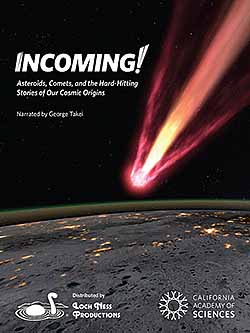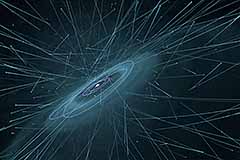 We’re excited to bring you the latest fulldome show from the California Academy of Sciences Morrison Planetarium: Incoming! It’s a hard-hitting look at how collisions have shaped our planet.
We’re excited to bring you the latest fulldome show from the California Academy of Sciences Morrison Planetarium: Incoming! It’s a hard-hitting look at how collisions have shaped our planet.
This original show explores the history of bombardment throughout the solar system, but particularly on Earth. There hasn’t been a time in our planet’s history when it wasn’t a target for something coming in from outer space. It was a major target throughout its formation, through a period called the Late Heavy Bombardment (which ended about 3.8 billion years ago).
Accretion and bombardment are how our planet grew, but impacts also affected our planet’s early atmosphere, and water-rich asteroids may have contributed to the buildup of Earth’s oceans. At least one major impact is thought to have contributed to the conditions that wiped out the dinosaurs some 65 million years ago. So, it’s understandable that humans are VERY interested in knowing what else is “out there” posing a threat to our planet and our lives.
Bringing Incoming! To Life
Incoming! is narrated by acclaimed actor George Takei (best known for his role as Hikaru Sulu in the Star Trek franchise, and his work on the stage, including the recent play Allegiance). In a press interview for the original opening, show writer-director Ryan Wyatt suggested that Mr. Takei’s familiar voice helps deliver somewhat frightening news in a way that reassures viewers.
Of course, no California Academy show would be complete without cutting-edge visualizations. In this show, they bring real-time data from current NASA missions to explain how collisions have shaped our world and others. This includes a look at the Chelyabinsk event of 2013 and the path the asteroid took as it encountered our planet.
 Recent discoveries of near-Earth objects (NEOs) “out there” cut a little TOO close to our planet. News of the Chelyabinsk fireball brought fears of planetary catastrophe home in a very visceral way. These appear in our skies frequently, although most of them are caused by rocks that are too small to do much damage when they hit the surface. As members of the public share their fear of cosmic catastrophes based on these events, this show can help worried planetarians answer some of those queries.
Recent discoveries of near-Earth objects (NEOs) “out there” cut a little TOO close to our planet. News of the Chelyabinsk fireball brought fears of planetary catastrophe home in a very visceral way. These appear in our skies frequently, although most of them are caused by rocks that are too small to do much damage when they hit the surface. As members of the public share their fear of cosmic catastrophes based on these events, this show can help worried planetarians answer some of those queries.
Assessing the Risks
Today, groups ranging from NASA scientists to private foundations are busily observing NEOs. Their data helps assess what dangers are posed.
Meteoroids and asteroid chunks aren’t the only things that slam into the surfaces of solar system worlds. Comets leave behind evidence of their passage through the solar system that eventually finds its way to Earth as meteors. But, they can also be impactors themselves, as we’ve seen numerous comets hit Jupiter or disappear into the Sun.
The concept of debris raining down on Earth is not always a comfortable one to consider. Most material that makes it through our atmosphere doesn’t pose much of a risk. But, there ARE objects out there that do. The more we know about them, the better prepared we are to figure out ways to deal with the monster impactors that come along every so often. Once your audiences have seen this show, they’ll come away with a much better understanding of the role of impacts on Earth—and elsewhere in the solar system.
Check out Incoming! and see if it’s right for you!

